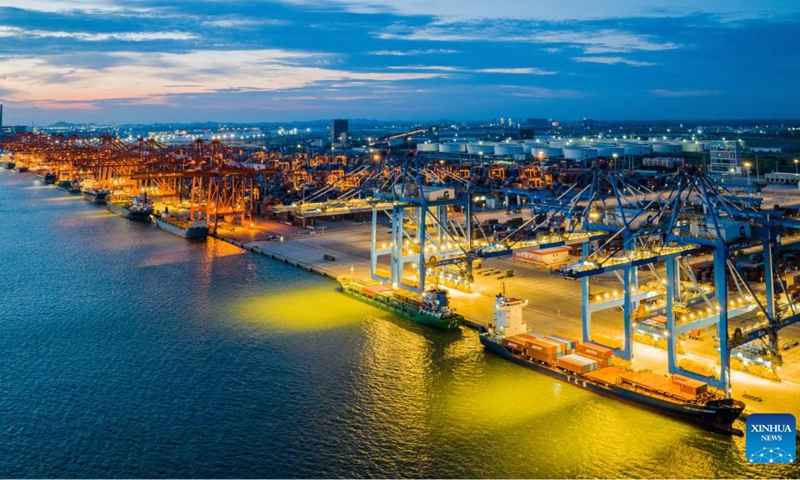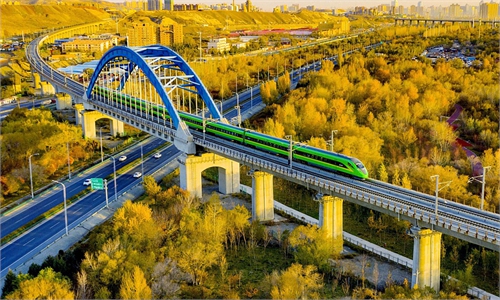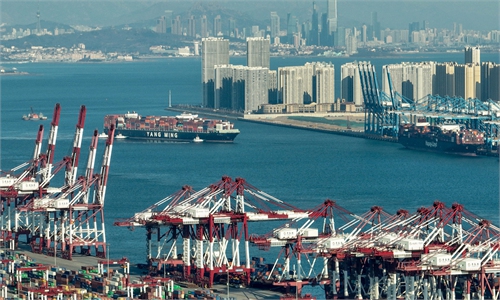China's middle, western provinces post faster GDP growth rates
Economy shows strong resilience, likely to grow by over 5% in Q4: expert

Aerial photo taken on Sept. 13, 2022 shows the night view of Qinzhou Port in Qinzhou, south China's Guangxi Zhuang Autonomous Region. Photo: Xinhua
The 31 provincial-level regions in Chinese mainland released their GDP numbers for the first three quarters as of Wednesday, with economic powerhouses including South China's Guangdong and East China's Jiangsu and Shandong provinces achieving a steady recovery despite COVID-19 flare-ups.
Meanwhile, middle and western regions that boast rich natural resources reported faster growth rates.
Experts said that the swift recovery in major provinces greatly contributed to a better-than-expected national economic rebound in the third quarter, with the country's GDP growth likely to pick up to reach more than 5 percent year-on-year in the fourth quarter of 2022.
Among the largest economic provinces, Guangdong saw its GDP grow by 2.3 percent year-on-year between January and September, Jiangsu was up by 2.3 percent and Shandong was up by 4 percent. East China's Zhejiang expanded by 3.1 percent, Central China's Henan Province was up by 3.7 percent and Southwest China's Sichuan Province up by 1.5 percent.
Contributing to about 45 percent of the country's total economic output, the six provinces are known as the pillars of China's economy.
The recovery is mainly due to a slew of favorable factors such as sustainable infrastructure investment, stable growth in foreign trade backed up by industrial and supply chain resilience, as well as domestic consumption recovery, Li Changan, a professor at the Academy of China Open Economy Studies of the International Business and Economics, told the Global Times on Wednesday.
Presiding over a symposium on the economic situation in August, Chinese Premier Li Keqiang urged the economic powerhouses to take a leading role in stabilizing economic growth by ensuring solid implementation of a package of pro-growth policies while leveraging policies to energize market entities, smooth logistics, and stabilize industrial and supply chains.
Reflecting its determination to promote economic growth and play a greater role in the nation's development this year, Zhejiang announced on Wednesday the construction of 72 large projects, with a total investment of 453.8 billion yuan ($62.3 billion).
Another outstanding characteristic of regional economic developments during the period was the faster GDP growth rates in middle and western regions, especially provinces that have rich natural resources. For example, North China's Shanxi Province saw its GDP grow by 5.3 percent on a yearly basis to reach 1.8 trillion yuan, according to data released by the local government.
As a major coal mining region, Shanxi has benefited from soaring energy prices, with the coal price hitting the highest levels since 2008. Official data showed that the province's coal output stood at 977.9 million tons in the first three quarters, up 10.5 percent year-on-year.
The province is also aiming for industrial upgrading. The province's investment in high-tech manufacturing, bio-medicine and equipment manufacturing grew by 37 percent, 36 percent and 16.4 percent, respectively.
And, North China's Inner Mongolia Autonomous Region, which has abundant coal, tin and iron ore, saw its GDP grow 5 percent year-on-year in the first nine months.
"The faster GDP growth rates among middle and western regions were within expectations, as the economic recovery in resource-rich regions came earlier due to the economic cycle," Cao Heping, an economist at Peking University, told the Global Times on Wednesday.
He forecast that the country's national GDP may grow by over 5 percent year-on-year for the fourth quarter, adding that localities' favorable economic policies and technological breakthroughs will play a role in driving growth. Li said that more policies to improve people's livelihoods and stabilize employment are expected to be announced.
A new government regulation to promote self-employed individual businesses came into force on Tuesday, offering fresh assistance to over 100 million individual businesses and seeking to address their immediate challenges.
Under the new regulation, policy support has been further extended to include measures like encouraging financial institutions to develop tailor-made financial products and services, optimizing vocational skills training, supporting business start-ups, as well as strengthening the protection of individual businesses' rights in shop names, trademarks, patents and trade secrets.



